John Westbrook at Antietam
28 August 2009
There are half a dozen unfinished posts waiting in the queue for this (very occasional) blog, but I am prompted to actually publish one at last by some fascinating email correspondence from Marianne Tierney, whose great-great-grandfather John Westbrook you see here. Marianne and her cousin Art Van Allsburg have collected and have shared some family treasures concerning their ancestor and Antietam.
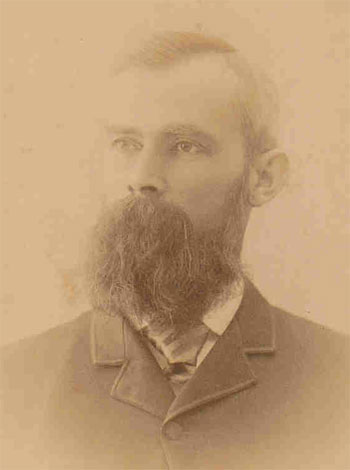

John Westbrook (postwar, courtesy M. Tierney)
This photograph is magnificent, but more exciting is a letter written by Marianne’ s grandfather Van Allsburg in 1964 which recalls what he heard from his grandfather Westbrook firsthand. With it, and some other tidbits I’ve dug up, we can follow something of this soldier’s life through and following the catastrophic Battle of Antietam …
Westbrook was born on 27 September probably in 1842 [44?] in Castile, in Wyoming County – a small town east of Buffalo in far western New York. Named for the city in Spain, it is now – as it was in the 1860s – a rural community of about 2000 residents close by a deep gorge on the Genesee River. By 1861, young John Westbrook was a farmer living across the canyon in Nunda, in Livingston County.


Western New York (from County Map Of The States Of New York, New Hampshire …, 1860)
And war had come to America. His grandson takes up the story:
1/
Look up the history of the battle of AntietamGr. pa [Grandpa] Jno. [John] Westbrook saw the Northern recruits marching South – as they passed his school hse. [house] 20 miles so. [south] of Buffalo, I am not certain but have reason to believe the troops were called the Green Mountain Men from Vermont –
I hope these men were not literally marching from Vermont to the defense of the capital, Washington DC, by way of Nunda, NY. From July through September a number of units were raised in and departed Vermont for the “front” – notably the 4th, 5th, and 6th Infantry Regiments. This was a period of active recruiting and intense excitement.
any how! he slid his books under the corner of the school house at age 19 he marched south with the Army.
John enlisted as a Private in Captain Henry Tuthill’s Company – which would soon become Company A of the 104th New York Volunteer Infantry, the Wadsworth Guards – on 25 October 1861. The other Company officers were 1st Lieutenant Lewis C. Skinner and 2nd Lieutenant Albert S. Haver. Tuthill had marched about 60 Nunda boys to the regimental rendezvous at Geneseo on September 30th, being the first to arrive.
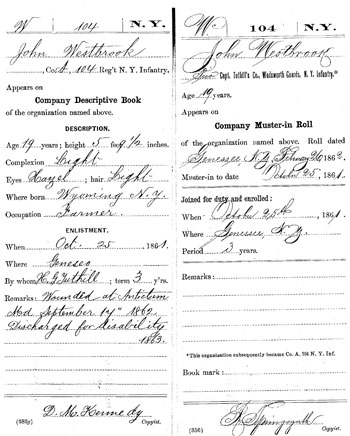

Combined Military Service Record cards (US War Department, 1892)
Private Westbrook and his mates trained at Camp Union, Geneseo as other recruited companies gathered and drilled with them between September 1861 and February 1862. John’s brother George soon joined him, enlisting in the Company in November. Company A formally mustered into 3-years Federal service on 26 February 1862. They were ordered to Albany as a Regiment on that date, and their Regimental Officers were commissioned on 8 March. Among these were John Rorbach, Colonel, R. Wells Kenyon, Lieutenant Colonel, and Nunda’s Lewis Skinner, the new Major.
Now officially the One Hundred and Fourth New York Volunteer Infantry, the Regiment left the state on 20 March by train for Washington DC. There they served under the command of the military governor of Washington – their namesake and sponsor, Brigadier General James S. Wadsworth – until posted to Catlett’s Station, Virginia early in May 1862.
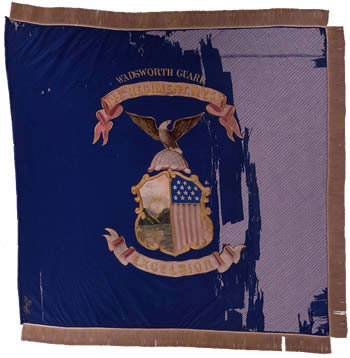
Battle flag of the 104th, presented at Catlett Station, Virginia, by Gen J. Wadsworth, 1862 (NY State Military Museum)
Wrote Nunda historian Henry Hand “This Regiment was particularly unfortunate in having many of its men captured by the enemy, also in having frequent changes of Officers, and in a disposition to quibble over minor matters. Several of the officers resigned, or were forced to do so. a lack of harmony seemed to prevail. The men, however, that escaped death and imprisonment re-enlisted, proving themselves brave and patriotic.”
Private Westbrook was counted “present” with the regiment continuously from his enlistment to 17 September 1862. During that time, he and his unit patrolled the vicinity of Warrenton, Virginia, were at Thoroughfare Gap, and finally, by 9 August got to Cedar Mountain. They saw a lot of marching but no actual combat in that period.
They were in action, though, at 2nd Bull Run on 30 August where they suffered their first casualties with 94 men killed, wounded or missing/captured. The Regiment’s two top officers, Colonel Rorbach and Lt. Colonel Kenyon, departed the Regiment ill soon after. Both were later discharged for disability, in October and September, respectively. This left Major Skinner in command as senior officer present.
In September the 104th moved on the Maryland campaign under Gen. McClellan; assaulted Turner’s Gap on South Mountain on 14 September, and lost 82 in killed, wounded and missing at Antietam early on the 17th, where the First (I) Corps, under Gen. Hooker, opened the battle before dawn.

Miller’s Cornfield, Sharpsburg, Maryland (author photo, September 2008)
Battle authority Ezra Carman narrated the action of the 104th New York at Antietam. They were in Abram Duryee’s brigade along with the 97th and 105th New York and 107th Pennsylvania Infantry Regiments, and …
“… Hartsuff’s and Duryee’s brigades were directed to flank to the right out of the Poffenberger woods and then advance south, Hartsuff in deployed line, with Duryee in column of divisions in close support on the right … It was daybreak when Hartsuff and Duryee obliqued to the right, out of the woods, to the grass fields east of the Joseph Poffenberger barn.”
“… Duryee, passing to the right, went through the North Woods and over Magilton’s brigade (which was lying in them), and halted in a plowed field, where a detail was made from the 105th New York to Captain James Thompson’s Battery C, Pennsylvania Light Artillery, which had accompanied the brigade and was short of men. The advance was resumed under a terrific fire of shot and shell from S.D. Lee’s guns, by which many were killed and wounded. Passing Matthew’s battery, the brigade went down a gentle incline, deployed along the north fence of the Miller Cornfield at about 5:45 a.m. (the 107th Pennsylvania on the right, and the 97th, 104th, and 105th, in order named, on the left), and the 1,100 men lay down.” [AotW map]
I think this is about where Mr Van Allsburg can catch us up with John Westbrook:
At the Battle of Antietam he was lying behind a rail fence, in back of a field of standing corn. When the So. [Southern] Army approached after the 1st volley of [ ] there was not a stalk of corn standing. His partner turned and told him his foot was shot off – two men with charcoal pots backed him up against a tree, and seared the arteries. One was shot working over him –
About 6:00 a.m. the rest of his regiment went over the fence, through the corn, and into even more murderous combat there and beyond, but Private Westwood’s battle was over. Also wounded in that action from the 104th were Company A’s Captain Tuthill, and about 60 others – including John’s older brother George, who was shot in the head. George survived to go home on a disability in December.
Due to his gunshot wound, John Westbrook had his right leg amputated and began his recovery from that traumatic event at the Smoketown Hospital, a tent hospital set up in a grove of trees about 1 – 1/2 miles from where he was hit.

Smoketown Hospital (c. 1862, from Bob Zeller’s Civil War Photography)
In additions to tents, many barns, homes, and churches for miles around Sharpsburg were pressed into service as hospitals for the large number of wounded from the battle. This put a terrible strain on the communities, and the many people – most civilians – who volunteered to help. Isabella Fogg, of the Maine Soldier’s Relief Agency said of the Smoketown Hospital in November:
“This place is in a most miserable condition, the men complain very much, although Mrs. Harris and several Penn. ladies, with a great quantity of supplies were there. The effluvia arising from the condition of these grounds is intolerable, quite enough to make a man in perfect health sick, and how men can recover in such a place is a mystery to me.”
And on a later visit she wrote … “Again we went to Smoketown, hoping to find them in a more comfortable condition than when we were last there, but how sadly were we disappointed… How I wish I could introduce you, and the Washington Com. to Smoketown Hos. in the midst of this driving snow storm! You could have seen the poor fellows huddled together, with their pallets of straw on the gound, their tents connected by flyes, the same as erected in the heat of summer, many without walls and no stoves. Those who were able to creep out of their tents were crouched over fires, built in the woods, their heads covered with snow. And all I may say, almost without exception with thin muslin shirts on.”
According to his service record data, Westbrook was at Smoketown Hospital through December 1862, at which time he was certified as totally disabled for service as a soldier. I believe the almost impossible signatures at the bottom of the Certificate are those of hospital director Dr Bernard A. Vanderkieft.
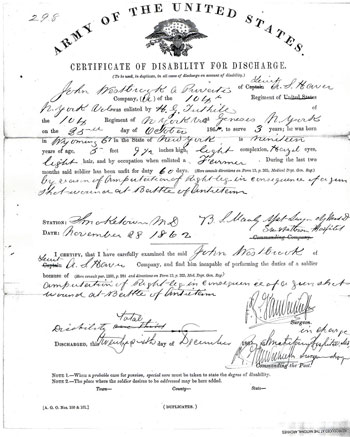

John Westbrook’s Certificate of Disability (US Army, 1862)
In April 1863 he was shown in Regimental records as being at the General Hospital, Washington, DC, and in August as being a “loss” to the Regiment, being discharged at Washington for disability. He was, however, as late as 11 November 1864, still recuperating – at the Columbia US General Hospital (possibly the Columbia College hospital located at 14th and Clifton Streets, NW).
As a result of being disabled, he was granted a monthly “Invalid” pension in May 1863, which he continued to receive for the rest of his life. His widow Phoebe (Phebe) also became eligible for one in 1920.
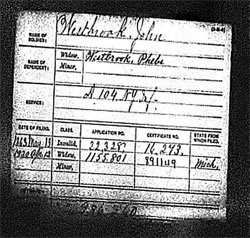
Pension records (courtesy Marianne Tierney)
After physically recovering, perhaps as part of what would now be called occupational therapy or re-training …
He was sent to Gloversville N.Y. and learned to make gloves – Indians furnished tanned deerhide in Michigan soft & pliable. – The deerhide best suited was eather side of the deers back bone for the length of the hide –
Perhaps not surprising, Gloversville was a center of glovemaking in the 1860s, becoming the ‘Glove Capital of the World’ in following decades. The Michigan Indians mentioned would likely have been those he encountered after April 1867 when…
Gr. Pa married Phoebe Ballou [1868] and the two homesteaded 160 @ [acres] 12 miles E. of Hart [Michigan] = In the woods = Their nearest neighbor was an Indian family 1 mile away. There were no rail-roads – they got to Pentwater [MI, on Lake Michigan] by boat, and walked the 12 miles into the woods, to their log cabin.
2/
The Gov’t pension built the log cabin, and roughly furnished it. Gr. Ma [Grandma] Phoebe Ballou belonged to Boston Ballous – Hoosie Ballou was a Boston Minister. Gr. Pa’s Gov’t pension supported him for life. After 10 yr’s at Elbridge [Michigan] he sold the farm for $10,000.00, and bought the home in Hart.
In that period, Oceana County, Michigan (top left on the map below, Detroit is lower right) was a frontier area.


central Michigan (from Asher & Adams’ Michigan, 1874)
The primary businesses – supported by shipping on Lake Michigan – were lumbering and farming, and clusters of houses and stores large enough to be called towns had only existed in the area since the mid 1850s. I find it extraordinary that a one-legged veteran would take on such a wilderness, but clearly he was successful there.
He got a new leg from the Gov’t every 3 or 4 yr’s with transportation pd. [paid] both ways to Buffalo N.Y. The improvement in cork leg’s thru the years was noticable.
When I was 4 yr’s old – possibly 6 yr’s – he took me to Buffalo with him for the new leg. We went by train to Detroit, and then by boat to Buffalo – an over night boat ride.
During more than 50 years of his life in Michigan, he made a living as a glover and farmer, raised a family, and contributed to his community. By 1890 – according to a local history – he was also making broom handles and had served the local community as Justice of the Peace, Township Treasurer, Highway Commissioner, Deputy Sheriff and Councilman. He was also a member of the Joe Hooker (Hart, MI) Post, Grand Army of the Republic, a national Union Veteran’s organization.
There are many Westbrooks in N.Y. State. Some migrated to Canada – there must still be many around N.Y.
“Nunday” [Nunda, NY] was the town 20 miles south of Buffalo. Gr. Pa’s father was a lawyer there. I have been there but don’t know how to spell it.
Gr. Pa’s one recreation was playing poker – they played weekly for high stakes = but he said none were 3 or $400.00 one way or another at the end of the year.
So, perhaps all was not work and no play.
After a very full life, John Westbrook died at about 78 years of age on 21 March 1920.
Gr. Pa and Grand Ma are buried on Dad’s family lot @ Hart.
____________________
Notes
I obtained Private Westbrook’s records – some reproduced here – from the Compiled Military Service Record [about CMSRs] for John Westbrook, Co. A, 104th NY Infantry from the US National Archives, Washington, DC.
The period New York and Michigan maps above are from original prints in the magnificent David Rumsey Collection online – one of the finest web presentations of a visual archive I know.
Phisterer’s view of the 104th and officers is online from the Internet Archives text collection.
Information about casualties in the 104th at Antietam are from Hough’s Duryee’s Brigade history at GoogleBooks and from Internet Archive.
Hand’s Nunda history is also nicely presented online from the IA. And, it includes these two faces (page 506):
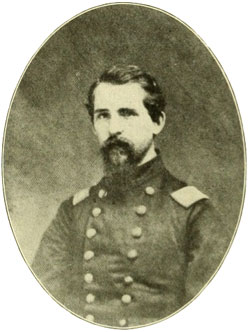
Henry G. Tuthill (c. 1862)
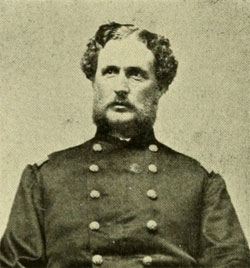
Lewis C. Skinner (c. 1862)
Lewis Skinner, incidentally, married two of Tuthill’s sisters, Delyea (to 1872), then Eliza.
More about George Westbrook (1841 – 1917) is online from Robert N. Colombo’s To Save the Union: Volunteers in the Civil War from Centerville, Hume and Granger Townships, Allegany County, New York (Westminster, MD: Heritage Books, 2007) – pages 163 and 297
Ezra Carman’s description of the Regiment’s actions on the morning of 17 September are from page 217 of Jake Pierro’s edition of his manuscript.
The Smoketown Hospital photo is from Bob Zeller’s The Blue and Gray in Black and White (Westport, CT: Praeger Publishers, 2005). Bob also runs a lovely organization/website called the Center for Civil War Photography.
Ms Fogg’s observations are from her report, in exhibit on AotW.
There’s a brief bio also of John Westbrook in Louis M. Hartwick and William H. Tuller’s Oceana County Pioneers and Business Men of Today, (Pentwater, MI: Pentwater News Steam Print, 1890). GoogleBooks has it online.
Grandson John Neal Van Allsburg’s (b. 1893, Michigan) 1964 letter of his recollections of his Grandfather Westbrook is transcribed in its entirety below. I posted the digital page images (1, 2) on AotW.
I interspersed this text in the post above except for the statement about John being captured at Antietam. I found no evidence that he was ever a prisoner of war in the military records. Though it’s not impossible, it seems unlikely, as very few Federal troops were exposed to capture in or near the Miller Cornfield on 17 September. I’m not sure what to make of that statement.
1/
Look up the history of the battle of AntietamGr. pa [Grandpa] Jno. [John] Westbrook saw the Nothern recruits marching South – as they passed his school hse. [house] 20 miles so. [south] of Buffalo, I am not certain but have reason to believe the troops were called the Green Mountain Men from Vermont –
any how! he slid his books under the corner of the school house at age 19 [probably 17] he marched south with the Army. At the Battle of Antietam he was lying behind a rail fence, in back of a field of standing corn. When the So. [Southern] Army approached after the 1st volley of [ ] there was not a stalk of corn standing. His partner turned and told him his foot was shot off – two men with charcoal pots backed him up against a tree, and seared the arteries. One was shot working over him –
He was taken prisoner and sent to Richmond Va – then traded back north in prisoner trade. [?]
He was sent to Gloversville N.Y. and learned to make gloves – Indians furnished tanned deerhide in Michigan soft & pliable. – The deerhide best suited was eather side of the deers back bone for the length of the hide –
Gr. Pa married Phoebe Ballou and the two homesteaded 160 @ [acres] 12 miles E. of Hart [Michigan] = In the woods = Their nearest neighbor was an Indian family 1 mile away. There were no rail-roads – they got to Pentwater [MI, on Lake Michigan] by boat, and walked the 12 miles into the woods, to their log cabin.
2/
The Gov’t pension built the log cabin, and roughly furnished it. Gr. Ma [Grandma] Phoebe Ballou belonged to Boston Ballous – Hoosie Ballou was a Boston Minister. Gr. Pa’s Gov’t pension supported him for life. After 10 yr’s at Elbridge [Michigan] he sold the farm for $10,000.00, and bought the home in Hart. He got a new leg from the Gov’t every 3 or 4 yr’s with transportation pd. [paid] both ways to Buffalo N.Y. The improvement in cork leg’s thru the years was noticable.When I was 4 yr’s old – possibly 6 yr’s – he took me to Buffalo with him for the new leg. We went by train to Detroit, and then by boat to Buffalo – an over night boat ride.
There are many Westbrooks in N.Y. State Some migrated to Canada – there must still be many around N.Y.
“Nunday” [Nunda, NY] was the town 20 miles south of Buffalo. Gr. Pa’s father was a lawyer there. I have been there but don’t know how to spell it.
Gr. Pa’s one recreation was playing poker – they played weekly for high stakes = but he said none were 3 or $400.00 one way or another at the end of the year.
Gr. Pa and Grand Ma are buried on Dad’s family lot @ Hart.

August 28th, 2009 at 7:30 am
Thank you so much for researching and putting this together which honors my great-great grandfather’s service and his life. This has been a journey for our family and I appreciate that you have been a part of our quest. Thanks you for your dedication in this website.
September 3rd, 2009 at 9:10 am
Brian,
Thanks for this excellent piece and great research on this veteran.
Larry
September 15th, 2009 at 10:27 pm
I enjoyed the accounts of Smoketown Hospital. There are several other images of the hospital that weren’t in my book.
September 16th, 2009 at 9:36 am
Thanks for coming by, Bob. Your Smoketown Hospital views are fantastic. There’s much online potential for more work on that hospital’s history.
September 16th, 2009 at 12:37 pm
Thanks as well for the link to CCWP. BZ
October 13th, 2009 at 12:36 am
This site is a beautiful gift to all his descendants who will follow with pride in their ancestor and gratitude to your efforts to preserve the memory of a Patriot.
Thank you
September 25th, 2010 at 8:53 am
This story came to me as I searched for additional information on my Great Great Great…Uncle Henry G. Tuthill.
I have letters from him from Antietam, Gettysburg and other active service encounters of Company A, and the 104th as he became Colonol of the regiment. I also have letters (over 800) from his sisters and brother dating from 1848 to 1890 and they chronicle his activies of becoming politically active, leaving his occupation to join the US Army and muster Co. A in Nunda NY. My letters are available for research, they are catalogued and they have been typed by my Aunt and Uncle and placed in a very thorough and complete geneological history of Henrys family. This is a spectacular first hand experience of the culmination of tension to the bittersweet post era of their the Northern victory from a Civil War family, it makes Cold Mountain (which I enjoyed) look like a short story. You should also search Charles Barber and you will find a book on Amazon that his family published. It to is a collection of letters from a private in Co. A. That book is really awesome. What a blessed man Charles Barber was! The title is “The Civil War Letters of Charles Barber” By Gary E. Swinson & Raymond G. Barber
September 25th, 2010 at 9:02 am
One additonal comment that I can confirm is not true. Henry Tuthills sisters were, Emiline (Never Married), Rachel Anne, (Never Married), Laura (Married David Bratton), and Sarah Jane (died in 1864 developmentally handicapped). So there was no marriage of Henrys sister by Lewis Skinner as your research suggests. The letter collection can be viewed in East Otto New York. We donated a copy of the published collection to their historical society. East Otto is the town of the Tuthills New York state homestead. I also have a copy of the collection at the Blue Pike Lakehouse in Ashtabula Ohio. This is a vacation rental and my renters love the letters.
August 29th, 2011 at 10:34 pm
My name is also John Westbrook, I was also born on 27 September, I also have light hair and eyes and sport a beard very close to the same style, had broken my right leg but did not lose it, enlisted in the Marines in the month of October like John and looked very close to his picture at that age when I was younger. Very interesting read I must say.
December 26th, 2011 at 9:48 am
The “almost impossible” signatures at the bottom of the Certificate of disabilaty for discharge of John Westbrook are indeed those of hospital director Dr Bernard A. Vanderkieft. There is absolutely no doubt about it, as far as I am concerned. Mr. Mike Fitzpatrick wrote a very interesting article about Dr Vanderkieft:”A Dutch Doctor in the Union Army” in Military Images of March/April 2001 with pictures of this very capable and appreciated doctor.
October 26th, 2017 at 9:15 pm
Very interesting story. I recently purchased a vintage Civil War walking stick but the name carved into it is James Westbrook. Did John ever go by the name James or might you know of a James in the family who also fought at Antietam which is also carved into the walking stick?
Thanks in advance for any information you may have.
October 17th, 2022 at 2:33 pm
[…] here’s a snapshot of Dr Vanderkieft’s unique signature, from the December 1862 Certificate of Disability for Discharge of Pvt John Westbrook, 104th New […]
March 23rd, 2024 at 12:27 pm
George Westbrook (brother of John) was a charter member of G.A.R. Hall Post #343, Hunt, town of Portage, Livingston Co., NY. On 27 Apr A. Lincoln Camp, Sons of Union Veterans of the Civil War, plans to dedicate a historical marker at the hall in Hunt, NY.